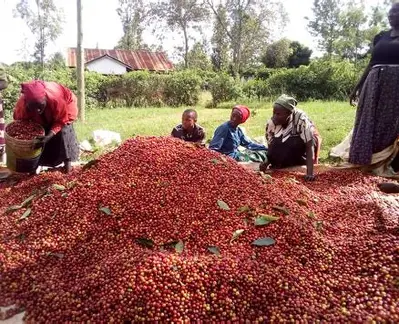
Ten counties, among them four in central Kenya, produced 91 per cent of total coffee in the country in the 2023-2024 crop season.
According to data released by the Agriculture and Food Authority (AFA), the 10 counties produced 43.3 million kilogrammes of clean coffee, representing 91 per cent of the total coffee produced during the season.
Kiambu County in central Kenya led production with 8.96 million kilogrammes translating to 18 per cent of the total output. The county’s coffee volume was drawn from 832 estates and 21 farmers’ cooperative societies, with the estates contributing to 6.98 million kilogrammes, which is nearly four times of 1.98 million kilogrammes that were produced by the local cooperatives.
Kirinyaga County emerged second after delivering 8.93 million kilogrammes representing 18 per cent of total volume. The county’s coffee entirely was produced by well-organised cooperative societies with only a small share of about 0.75 million produced by estates.
Nyeri County followed with 6.52 million kilogrammes (13.2 per cent), driven largely by cooperatives societies with 5.67 million kilogrammes and supported by a modest estate sector, which produced 0.85 million kilogrammes.
Murang’a County added 5.07 million kilogrammes equivalent to 10.3 per cent, of which cooperatives contributed 4.47 million kilogrammes and estates 0.60 million kilogrammes.
The AFA data further revealed Kericho County produced 4.84 million kilogrammes (9.8 per cent), with 3.96 kilogrammes coming from cooperatives societies and 0.89 kilogrammes complemented by estates.
The top five Counties collectively dominate the sector, accounting for approximately 69.4 per cent of total production among the top 10 Counties.
The remaining five Counties contribute smaller but still significant volumes with Bungoma County contributing 2.36 million kilogrammes or 4.8 per cent, largely from smallholder cooperatives that produced 2.21 million kilogrammes.
Meru produced 2.3 million kilogrammes (4.7 per cent), Embu 2.19 million kilogrammes (4.4 per cent), Nandi County contributed 1.8 million kilogrammes (3.7 per cent), while Machakos rounded up the top 10 with 1.3 million kilogrammes (2.7 per cent).
The 10 counties illustrate Kenya’s dual coffee production model, one powered by large, well-managed estates such as those in Kiambu County and the other sustained by vibrant farmers’ cooperative societies.
Kiambu’s estates alone outperformed the cooperative sectors of most other top counties, underscoring their scale and efficiency.
Collectively, the counties form the backbone of Kenya’s coffee industry, blending the strength of commercial estates with the resilience of smallholder farmers who keep the country’s coffee heritage alive.
- A Tell Media / KNA report / By Bernard Munyao








